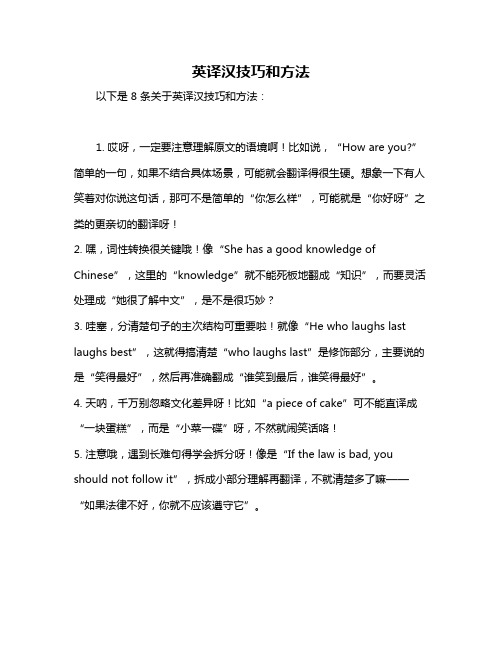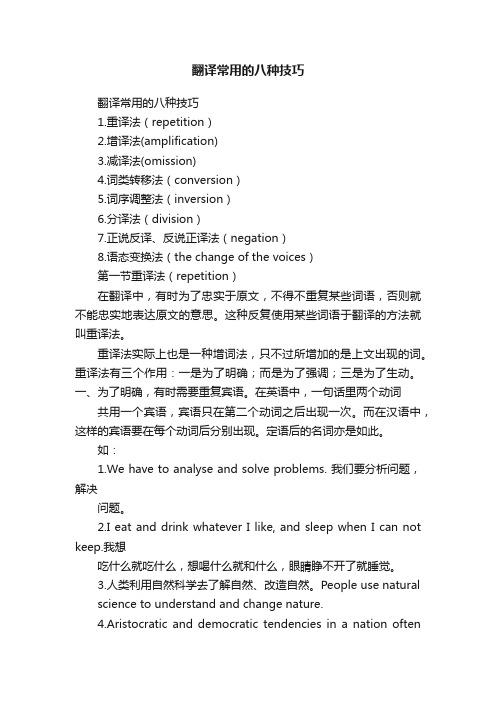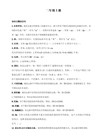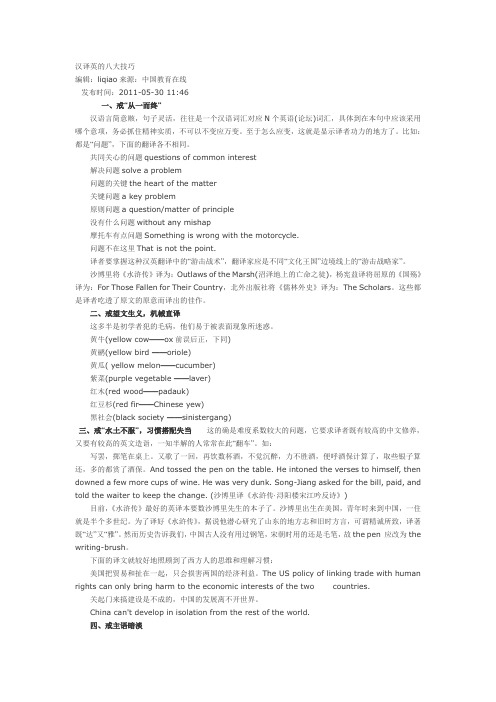英汉互译八种技巧
英译汉技巧和方法

英译汉技巧和方法以下是 8 条关于英译汉技巧和方法:1. 哎呀,一定要注意理解原文的语境啊!比如说,“How are you?” 简单的一句,如果不结合具体场景,可能就会翻译得很生硬。
想象一下有人笑着对你说这句话,那可不是简单的“你怎么样”,可能就是“你好呀”之类的更亲切的翻译呀!2. 嘿,词性转换很关键哦!像“She has a good knowledge of Chinese”,这里的“knowledge”就不能死板地翻成“知识”,而要灵活处理成“她很了解中文”,是不是很巧妙?3. 哇塞,分清楚句子的主次结构可重要啦!就像“He who laughs last laughs best”,这就得搞清楚“who laughs last”是修饰部分,主要说的是“笑得最好”,然后再准确翻成“谁笑到最后,谁笑得最好”。
4. 天呐,千万别忽略文化差异呀!比如“a piece of cake”可不能直译成“一块蛋糕”,而是“小菜一碟”呀,不然就闹笑话咯!5. 注意哦,遇到长难句得学会拆分呀!像是“If the law is bad, you should not follow it”,拆成小部分理解再翻译,不就清楚多了嘛——“如果法律不好,你就不应该遵守它”。
6. 哎呀呀,适当增减词会让翻译更通顺呢!比如“He gave me a book”翻成“他给了我一本书”,要是原文强调只给了一本,那就可以加上“仅仅”之类的词更准确。
7. 哈哈,反复琢磨很有必要呀!像“Love me, love my dog”要是不仔细想,可能就翻译成“爱我,爱我的狗”,这就不对啦,应该是“爱屋及乌”呀!8. 记住哟,选取合适的汉语词汇来对应英语很有讲究哒!比如说“black tea”总不能翻成“黑茶”,而是“红茶”呀!总之,英译汉靠的就是这些小技巧和方法,多练多总结准没错!。
翻译常用的八种技巧

翻译常用的八种技巧翻译常用的八种技巧1.重译法(repetition)2.增译法(amplification)3.减译法(omission)4.词类转移法(conversion)5.词序调整法(inversion)6.分译法(division)7.正说反译、反说正译法(negation)8.语态变换法(the change of the voices)第一节重译法(repetition)在翻译中,有时为了忠实于原文,不得不重复某些词语,否则就不能忠实地表达原文的意思。
这种反复使用某些词语于翻译的方法就叫重译法。
重译法实际上也是一种增词法,只不过所增加的是上文出现的词。
重译法有三个作用:一是为了明确;而是为了强调;三是为了生动。
一、为了明确,有时需要重复宾语。
在英语中,一句话里两个动词共用一个宾语,宾语只在第二个动词之后出现一次。
而在汉语中,这样的宾语要在每个动词后分别出现。
定语后的名词亦是如此。
如:1.We have to analyse and solve problems. 我们要分析问题,解决问题。
2.I eat and drink whatever I like, and sleep when I can not keep.我想吃什么就吃什么,想喝什么就和什么,眼睛睁不开了就睡觉。
3.人类利用自然科学去了解自然、改造自然。
People use naturalscience to understand and change nature.4.Aristocratic and democratic tendencies in a nation oftenshowthemselves in its speech.民族的贵族倾向和民族倾向常在其言语中表现出来。
5.我们来修改安全规则和卫生规则吧。
Let’s revise our safety andsanitary regulations.二、英语常用省略,但为了明确,也为了强调某些内容,在汉语中常常要将省去的部分重译出来。
英文翻中文的八大翻译技巧

英文翻中文的八大翻译技巧要真正掌握英文翻译的技巧并非易事。
这是因为英译汉时会遇到各种各样的困难,下面就和大家分享英文翻中文的八大翻译技巧推荐,来欣赏一下吧。
英文翻中文的八大翻译技巧推荐首先是英文理解难,这是学习、使用英文的人的共同感觉,由于两国历史、文化、风俗习惯的不同,所以一句英文在英美人看来顺理成章,而在中国人看来却是颠颠倒倒、断断续续,极为别扭。
二是中文表达难,英译汉有时为了要找到一个合适的对等词汇,往往被弄得头昏眼花,好像在脑子里摸一个急于要开箱子的钥匙,却没有。
另外,英译汉时对掌握各种文化知识的要求很高,因为我们所翻译的*,其内容可能涉及到极为广博的知识领域,而这些知识领域多半是我们不大熟悉的外国的事情,如果不具备相应的文化知识难免不出现一些翻译中的差错或笑话。
正是因为英译汉时会遇到这么多的困难,所以,我们必须通过翻译实践,对英汉两种不同语言的特点加以对比、概况和总结,以找出一般的表达规律来,避免出现一些不该出现的翻译错误,而这些表达的规律就是我们所说的翻译技巧。
一、词义的选择和引伸技巧英汉两种语言都有一词多类和一词多义的现象。
一词多类就是指一个词往往属于几个词类,具有几个不同的意义;一词多义就是同一个词在同一词类中又往往有几个不同的词义。
在英译汉的过程中,我们在弄清原句结构后,就要善于运用选择和确定原句中关键词词义的技巧,以使所译语句自然流畅,完全符合汉语习惯的说法;选择确定词义通常可以从两方面着手:1、根据词在句中的词类来选择和确定词义They are as like as two peas .他们相似极了。
(形容词)He likes mathematics more than physics .他喜欢数学甚于喜欢物理。
(动词)Wheat, oat, and the like are cereals .小麦、燕麦等等皆系谷类。
(名词)2、根据上下文联系以及词在句中的搭配关系来选择和确定词义。
英汉互译八种技巧 ppt课件

(表语有多个修饰语时,重 of fear as well as of admiration.
❖ 无知是恐惧的根源,也是崇拜的根源。
3)重复名词,取代代词 ❖ Don’t be afraid of failure, as it is the mother
❖ 4. 保留习语中的重复 ❖ Long, long ago… ❖ 很久很久以前,··· ❖ The flower is very ,very beautiful. ❖ 这花可美可美了。 5,英语强势词的译法 Whatever, whatsoever, whoever, whomever,
whichever, whenever, wherever, however.
❖ 1.重复名词 ❖ 1)重复做宾语的名词
❖ We have to analyze and solve problems. ❖ 我们要分析问题,解决问题。
❖ Let’s revise our safety and sanitary regulations. ❖ 我们来修改安全规则和卫生规则吧。
❖ Gentlemen may cry, peace, peace --- but there is no peace.
❖ 先生们尽管可以高呼和平,和平!但是依然没有和 平。
❖ We must enrich our cultural and material lives.
我们必须丰富我们的精神生活和物质生活。 (宾语前有多个定语时,要重复这个做宾语 的名词)
2)重复做表语的名词
This is a victorious conference that shows our unity.
❖ You may take whatever away for all I care. ❖ 你想拿什么拿什么,我才不管哩。
最常用的十大翻译技巧

This is yet another common point between the people of our two countries.(增译介词)
(7)在人权领域,中国反对以大欺小、以强凌弱。
In the field of human rights, China opposes the practice of the big oppressing the small and the strong bullying the weak.(增译暗含词语)
如:
(1) Increased cooperation with China is in the interests of the United States.
同中国加强合作,符合美国的利益。 (在主谓连接处拆译)
(2)I wish to thank you for the incomparable hospitality for which the Chinese people are justly famous throughout the world.
在有些欧洲国家里,人民享受最广泛的社会福利,如医疗保险等。(被动语态转主动语态)
(8)时间不早了,我们回去吧!
We don’t have much time left. Let’s go back. (句型转换)
(9)学生们都应该德、智、体全面发展。
All the students should develop morally, intellectually and physically. (名词转副词)
You can obtain this information on the Internet. (正译)
英汉互译八种技巧

注意事项
保持原文的语义和语法正确
在直译过程中,要确保译文准确地传达了原文的语义和语法,避 免出现歧义或误解。
尊重原文的文化特色
直译法要尊重原文的文化特色,尽可能保留原文的文化信息,避免 因文化差异而引起的误解。
符合目标语言的表达习惯
尽管直译法强调保持原文的形式,但译文仍需符合目标语言的表达 习惯,以使读者能够更好地理解和接受。
注意事项
准确理解原文
在运用直译与意译结合法时,首 先要准确理解原文的意思,避免
因理解错误而导致翻译错误。
灵活调整词序
在直译与意译结合的过程中,需 要根据汉语的表达习惯灵活调整 英文原句的词序,使译文更加自
然流畅。
保持原文风格
在翻译过程中,要尽量保持原文 的风格和语言特色,如比喻、修 辞等,以使译文更加贴近原文。
注意事项
加注应当符合目标语言的表达习惯和规范,避免出现 语法错误或表达不当的情况。
加注应当简洁明了,避免过多的解释和说明,以免影 响读者的阅读体验。
加注应当尽可能地保留原文的信息和意义,避免出现 信息丢失或误解的情况。
THANKS FOR WATCHING
感谢您的观看
文的含义。
符合目标语言习惯
意译法要求译文符合目标语言的表 达习惯和语法规则,避免出现生硬 或不符合规范的语言表达。
保持原意不变
意译法的核心是保持原文意思不变, 因此在翻译过程中要特别注意保持 原意的完整性和准确性,避免出现 信息的遗漏或误解。
04
音意结合法
定义
• 音意结合法是指在进行英汉互译 时,将英文的发音和汉语的意义 结合起来,以达到准确传达原文 意思的目的。
和文化背景。
适用范围
当源语言与目标语言存在较大 的文化差异和语言结构差异时, 归化法可以发挥很好的作用。
汉译英的八大技巧

汉译英的八大技巧编辑:liqiao来源:中国教育在线发布时间:2011-05-30 11:46一、戒“从一而终”汉语言简意赅,句子灵活,往往是一个汉语词汇对应N个英语(论坛)词汇,具体到在本句中应该采用哪个意项,务必抓住精神实质,不可以不变应万变。
至于怎么应变,这就是显示译者功力的地方了。
比如:都是“问题”,下面的翻译各不相同。
共同关心的问题questions of common interest解决问题solve a problem问题的关键the heart of the matter关键问题a key problem原则问题a question/matter of principle没有什么问题without any mishap摩托车有点问题Something is wrong with the motorcycle.问题不在这里That is not the point.译者要掌握这种汉英翻译中的“游击战术”,翻译家应是不同“文化王国”边境线上的“游击战略家”。
沙博里将《水浒传》译为:Outlaws of the Marsh(沼泽地上的亡命之徒),杨宪益译将屈原的《国殇》译为:For Those Fallen for Their Country,北外出版社将《儒林外史》译为:The Scholars。
这些都是译者吃透了原文的原意而译出的佳作。
二、戒望文生义,机械直译这多半是初学者犯的毛病,他们易于被表面现象所迷惑。
黄牛(yellow cow——ox前误后正,下同)黄鹂(yellow bird ——oriole)黄瓜( yellow melon——cucumber)紫菜(purple vegetable ——laver)红木(red wood——padauk)红豆杉(red fir——Chinese yew)黑社会(black society ——sinistergang)三、戒“水土不服”,习惯搭配失当这的确是难度系数较大的问题,它要求译者既有较高的中文修养,又要有较高的英文造诣,一知半解的人常常在此“翻车”。
翻译常用的八种翻译技巧

翻译常用的八种翻译技巧一.重译法1.We have to analyze and solve problems.2.I have finished my assigned work ahead of time, so has he.3.Ignorance is the mother of fear as well as admiration.4.大家庭有大家庭的难处。
5.促进政党关系,民族关系,宗教关系,阶层关系,海内外同胞关系的和谐,对于促进团结、凝聚力量具有不可替代的作用。
二.增译法1. I am looking forward to the holidays.2. Much of our morality is customary.3. 虚心使人进步,骄傲使人落后。
4. 小不忍则乱大谋。
三.减译法1. Mr. Bingley was good-looking and gentle-like.2. Sunday is the day when I am least busy.3.中国绝不会做损人利己,以邻为壑的事情。
4.发展为了人民,发展依靠人民,发展成果由人民共享。
四.词类转换法1. In those years the Republicans were in.2. His real mission in life was to contribute, in one way or another, to the overthrow of capitalist society.3. Independent observers have commented favorably on the achievements you have made in this direction.4. 一定要少说空话,多做工作。
5.徐悲鸿画马画得特别好。
五.词序调整法1. He is not happy, though he is rich.2. But it is too late to try for strength now through nourishment.3. 能源,交通,通信等基础设施和重点工程建设成效显著。
- 1、下载文档前请自行甄别文档内容的完整性,平台不提供额外的编辑、内容补充、找答案等附加服务。
- 2、"仅部分预览"的文档,不可在线预览部分如存在完整性等问题,可反馈申请退款(可完整预览的文档不适用该条件!)。
- 3、如文档侵犯您的权益,请联系客服反馈,我们会尽快为您处理(人工客服工作时间:9:00-18:30)。
使译文合乎表达习惯,必须增加一些词语,这就 叫增译法. 增词义增加虚词为多,也可酌量增加实词。 英译汉时经常增加的词有结构词、数量词、 概念词、语气词等。 从增补的功能来看,可以分为结构增补、意 义增补和修辞增补。
I am looking forward to the holidays. 我们等待假日的到来。 Much of our morality is customary. 我们大部分的道德观念都有习惯性。 Reading makes a full man; conference a ready man; and writing an exact man. 读书使人充实,讨论使人机智,笔记使人精确。 Histories make men wise; poets witty; the mathematics subtle; natural philosophy deep; moral grave; logic and rhetoric able to contend. 读史使人明智,读诗使人灵秀,数学使人周密,科 学使人深刻,伦理使人庄重,逻辑修辞之学使人善 辩。
寻寻觅觅,冷冷清请,凄凄惨惨戚戚;乍暖还寒 时侯,最难将息。 (译文1)
Seek, seek; search, search; Cold, cold; bare, bare; Grief, grief; cruel, cruel grief. Now warm, then like the autumn cold again, How hard to calm the heart!
先生们尽管可以高呼和平,和平!但是依然没有和 平。
We
must enrich our cultural and material lives. 我们必须丰富我们的精神生活和物质生活。 (宾语前有多个定语时,要重复这个做宾语 的名词) 2)重复做表语的名词 This is a victorious conference that shows our unity. 这是一个胜利的大会,一个团结的大会。 (表语有多个修饰语时,重复做表语的名词)
6.重复副词 Nels
had it all written out neatly. 纳尔斯把它写得清清楚楚。 By and by the building rose up. 楼房一点一点地升起来了。 7,使用四字词组 Come over and have a rest. 过来休息休息。
Ignorance
is the mother of fear as well as of admiration. 无知是恐惧的根源,也是崇拜的根源。
3)重复名词,取代代词 Don’t be afraid of failure, as it is the mother of success. 不要害怕失败。失败是成功之母。 Translation form Chinese into English is not so easy as that form English into Chinese. 汉译英不像英译汉那么容易。 A large family has its difficulties. 大(家庭)有大(家庭)的难处。
保留习语中的重复 Long, long ago… 很久很久以前,· · · The flower is very ,very beautiful. 这花可美可美了。 5,英语强势词的译法 Whatever, whatsoever, whoever, whomever, whichever, whenever, wherever, however.
他后来回到印度,一提起那一段逍遥自在的日子, 总是眉飞色舞。 She spoke little and then after long meditation. 她少言寡语,而且总是在深思熟虑之后才开口。
To
be continued!
2. 增译法
为了使译文忠实地表达原文的意思与风格并
1.重复名词 1)重复做宾语的名词 We have to analyze and solve problems. 我们要分析问题,解决问题。 Let’s revise our safety and sanitary regulations. 我们来修改安全规则和卫生规则吧。 Gentlemen may cry, peace, peace --- but there is no peace.
He is young but ambitious. 他人小志大。 She was small and slight, pale, but very beautiful. 她身量瘦小,面色苍白,但模样倒很漂亮。 I don’t care about it. You may please yourself. 我倒无所谓,随你的便吧。 Just look at her face, red as an apple. 你瞧她的脸哟,红得像个苹果似的。
这种人闹什么东西呢?闹名誉,闹地位,闹出风头。 What are they after? They are after name, after position, and they want to cut smart figure. 天苍苍,野茫茫,风吹草低见牛羊。 The sky is blue, blue; And the steppe wide, wide; Over grass that the wind has battered low; Sheep and oxen roam.
Such a trifling thing is hardly worth mentioning. 区区小事,不足挂齿。 On returning to India, and ever after, he used to speak of the pleasure of this period of his existence with great enthusiasm.
翻译常用的八种技巧
常用的翻译技巧
1. 重复法 (repetition) 2. 增译法 (amplification) 3. 减译法 (omission) 4. 词类转换法 (conversion) 5. 词序调整法 (inversion) 6. 分译法 (division) 7. 正说反译, 反说正译法 (negation)(反译法) 8. 语态 变换法 (the change of the voices)
2. 重复动词 You’ve read more books than I have. 你读的书比我读的多。 He succeeded because of his good luck rather than of his ability. 他的成功靠的是运气,而不是靠的能力。 He went to bed again, and thought and thought and thought it over and over. 他有又上床去,左思右想,想个不停。
5. 只许州官放火, 不许百姓点灯。 The magistrate are free to burn down houses, while the common people are forbidden even to light lamps.
(One man may steal a horse, while another may not look over the hedge.) 6. 班门弄斧 Showing off one’s proficiency with the axe before Lu Ban the master carpenter. 7. 三个臭皮匠, 顶个诸葛亮。 Three cobblers with their wits combined equal Zhuge Liang the master mind. 8. 留得青山在, 不怕没柴烧。 So long as green hills remain, there will never be a shortage of firewood.
3. 减译法
增译法的反面
减译法是指原文中有些词在译文中不译出来,
因为译文中虽无其词而已有其意,或者在译文 中是不言而喻的; 减译法是删去一些可有可无的, 或者有了反而 累赘或违背译文习惯表达法的词, 并不是把原 文的某些思想内容删去。
省译和增Leabharlann 是相辅相成的两种翻译技巧。省译和分为结构省译和精炼压缩。 所谓结构省译是由于英汉两种语言在句子结 构上的差异造成的。在英译汉时经常省略的 词有代词、系词、介词、连词、冠词、先行 词等。 作主语和定语的人称代词以及做定语 的物主代词均可省译。 如果把结构省译看作是消极的省译手段,那 么精炼压缩则是积极的省译手段,前者明显, 后者隐晦。
(译文2)
I seek but seek in vain, I search and search again; I feel so sad, so drear, So lonely, without cheer. (许渊冲译)
青青河边草, 郁郁园中柳。 Green grows the grass upon the bank, The willow shoots are long and lank. 3 保留谚语中的重复 Out of sight, out of mind. 眼不见,心不念。 Work while you work, play while you play. 干要干得投入,玩要玩得尽兴。
4. 交出翻译之前,必须读几遍,看看有没有要修改 的地方. 这样你才能把工作做好。 Before handing in your translation, you have to read it over and over again and see if there is anything in it to be corrected or improved. Only thus can you do your work well.
